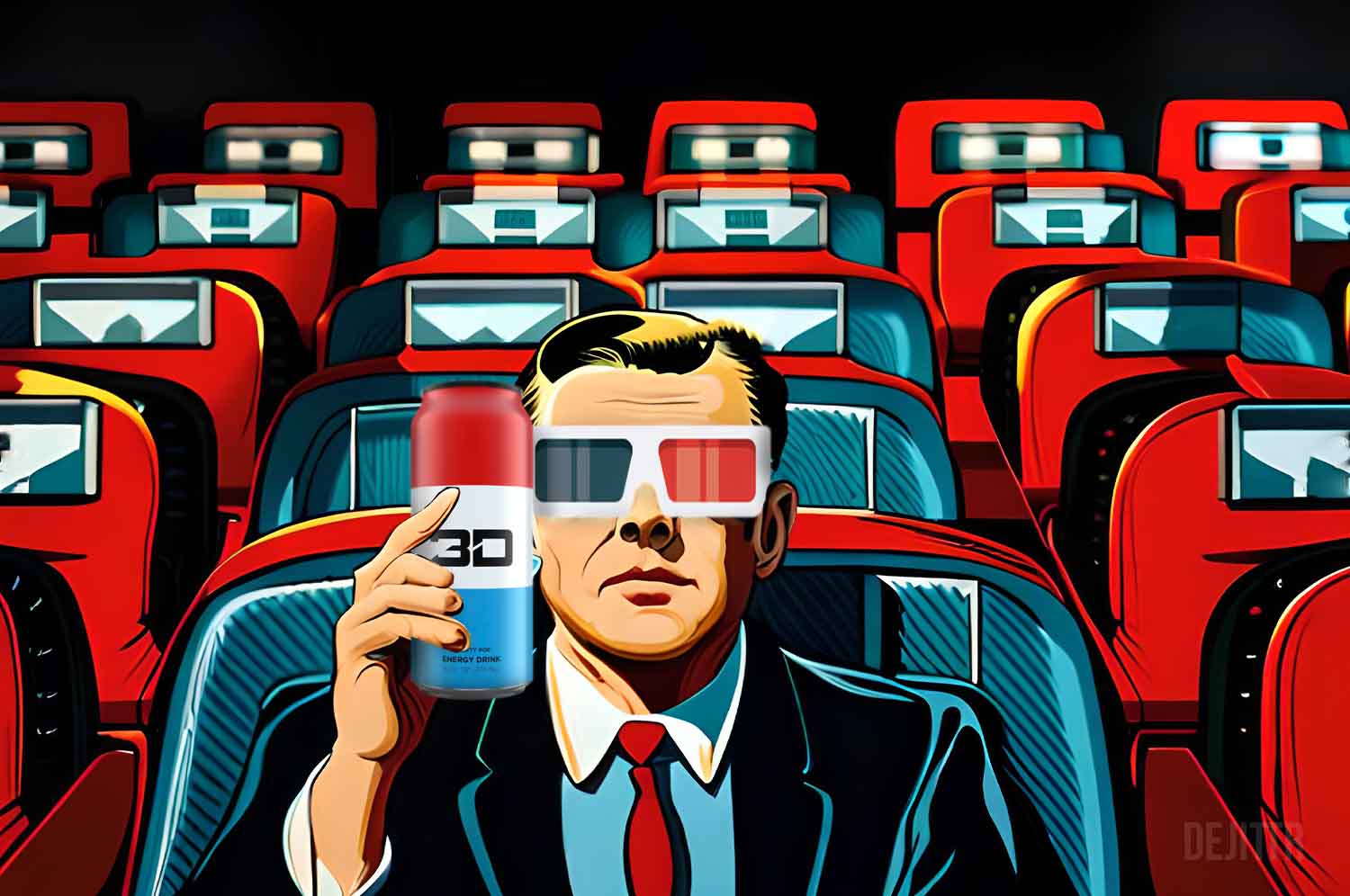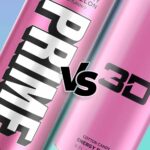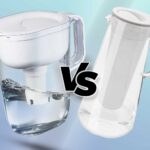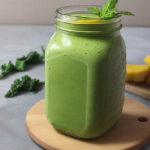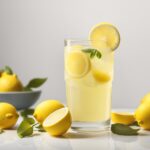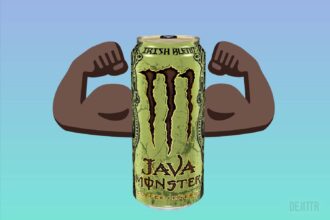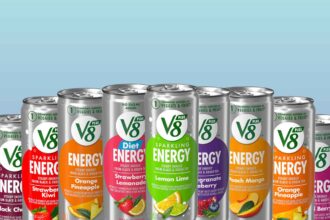So, I found this cool fizzy drink called 3D Energy Drink, and I can’t wait to share what I learned with you all.
Hold on, don’t just click away thinking this is another boring energy drink review.
We’re going on an exciting journey, exploring the cool details of what’s inside the drink, figuring out if it’s healthy or not, and revealing any hidden risks that might be hiding in that bright can.
But there’s more! We’ll also dig into the nutrition facts of 3D Energy Drink, compare the good and bad points, and lots more.
Ready? Let’s dive in…
What Are The Active Ingredients In 3D Energy Drink?
| Ingredient | Overview |
| Taurine | Taurine is an amino acid that supports neurological development and helps regulate the level of water and minerals in the blood. It is added for its potential to improve athletic performance and mental focus. Taurine is generally considered safe, but excessive intake may cause side effects. |
| Caffeine | Caffeine is a natural stimulant found in coffee, tea, and other plants. It is added to boost alertness, focus, and physical performance. While moderate consumption is safe for most people, excessive intake can lead to side effects like insomnia, jitters, and increased heart rate. |
| Panax Ginseng Root Extract | Panax ginseng is a plant extract known for its potential benefits in improving mental clarity, focus, and energy levels. It is added to enhance mental and physical performance. Although generally safe, excessive consumption may cause side effects like insomnia and digestive issues. |
| L-Carnitine | L-Carnitine is an amino acid derivative that helps transport fatty acids into cells for energy production. It is added to support weight loss and athletic performance. Generally considered safe, but excessive intake may cause side effects like nausea, diarrhea, and body odor. |
| Glucuronolactone | Glucuronolactone is a naturally occurring compound that helps detoxify the body. It is added for its potential to boost energy and improve mental focus. There is limited research on its safety, but it is generally considered safe when consumed in moderate amounts. |
| Inositol | Inositol is a naturally occurring carbohydrate that aids in various physiological functions. It is added to support brain function and mood regulation. Generally considered safe, but excessive intake may cause side effects like diarrhea and gastrointestinal discomfort. |
| Guarana Seed Extract | Guarana is a plant extract that contains caffeine and other stimulants. It is added to enhance alertness, focus, and physical performance. Although generally safe, excessive consumption may cause side effects similar to those of caffeine, like insomnia and increased heart rate. |
| Carbonated Water | Carbonated water is water that has been infused with carbon dioxide gas under pressure. It provides the drink’s effervescent texture and has no known health benefits or drawbacks. |
| Citric Acid | Citric acid is a weak organic acid that occurs naturally in citrus fruits. It is added to give the drink a tart flavor and to act as a preservative. It is generally safe, but excessive intake may cause tooth erosion and gastrointestinal upset. |
| Erythritol | Erythritol is a sugar alcohol used as a low-calorie sweetener. It is added to provide sweetness without adding calories. Generally considered safe, but excessive intake may cause gastrointestinal issues like gas and bloating. |
| Sodium Citrate | Sodium citrate is a sodium salt of citric acid used as a flavor enhancer and a preservative. It is generally safe, but excessive intake may lead to an electrolyte imbalance or increased sodium levels. |
| Sucralose | Sucralose is an artificial sweetener that is added to provide sweetness without adding calories. It is generally considered safe, but some studies suggest potential negative effects on gut bacteria and glucose metabolism. |
| Sodium Benzoate (Preservative) | Sodium benzoate is a widely used food preservative that helps prevent spoilage. It is generally safe, but excessive intake may cause side effects like headaches, nausea, and allergic reactions |
| Potassium Sorbate (Preservative) | Potassium sorbate is a food preservative used to prevent mold and yeast growth. It is generally considered safe, but excessive intake may cause side effects like skin irritation, nausea, and diarrhea. |
| Acesulfame Potassium | Acesulfame potassium is an artificial sweetener that is added to provide sweetness without adding calories. It is generally considered safe, but some studies suggest potential negative effects on gut bacteria and glucose metabolism. |
| Gum Acacia | Gum acacia, also known as gum arabic, is a natural gum made from the sap of acacia trees. It is added as a thickener and stabilizer to improve the texture of the drink. It is generally considered safe, but excessive intake may cause gastrointestinal issues like gas and bloating. |
| Niacinamide (Vitamin B-3) | Niacinamide is a form of vitamin B-3 that is essential for energy production and metabolism. It is added to support overall health and prevent vitamin deficiency. Generally considered safe, but excessive intake may cause side effects like flushing, itching, and gastrointestinal upset. |
| D-Glucuronolactone | D-Glucuronolactone is an isomer of glucuronolactone, a naturally occurring compound that helps detoxify the body. It is added for its potential to boost energy and improve mental focus. There is limited research on its safety, but it is generally considered safe when consumed in moderate amounts. |
| Sodium Chloride | Sodium chloride, also known as table salt, is added to enhance the flavor of the drink. Excessive intake can lead to increased blood pressure and other health issues, but the amount present in energy drinks is typically not a cause for concern. |
| Calcium D Pantothenate (Vitamin B-5) | Calcium D Pantothenate is a form of vitamin B-5 that is essential for energy production and metabolism. It is added to support overall health and prevent vitamin deficiency. Generally considered safe, but excessive intake may cause diarrhea and gastrointestinal discomfort. |
| Pyridoxine Hydrochloride (Vitamin B-6) | Pyridoxine hydrochloride is a form of vitamin B-6 that is essential for brain function and the production of red blood cells. It is added to support overall health and prevent vitamin deficiency. Generally considered safe, but excessive intake may cause nerve damage and other issues. |
| FD&C Blue 1 | FD&C Blue 1 is a synthetic food dye used to give the drink its blue color. It is approved for use in food and beverages, but some studies have linked its consumption to allergic reactions and hyperactivity in children. Most people can consume it safely in moderate amounts. |
| Cyanocobalamin (Vitamin B-12) | Cyanocobalamin is a form of vitamin B-12 that is essential for nerve function and the production of red blood cells. It is added to support overall health and prevent vitamin deficiency. Generally considered safe, but excessive intake may cause side effects like headache and dizziness. |
Is 3D Energy Drink Healthy?
Let’s see whether this drink is healthy.
3D Energy Drink is low-calorie and sugar-free. That’s great for those who desire low-calorie beverages. Vitamins B-3, B-5, B-6, and B-12 boost energy and physiological function.
But consider these risks. Some people may be affected by the drink’s caffeine. Caffeine may cause shakiness, insomnia, and a quicker pulse. Caffeine-sensitive people should avoid this drink.
Sodium content is another factor to take into account. 3D Energy Drink contains salt, which may be a concern for those with high blood pressure.
Finally, the drink contains sucralose and acesulfame potassium, artificial sweeteners. These are safe for most, but some may worry.
3D Energy Drink: healthy? For low-calorie, sugar-free energy drinks, it may work. However, everyone is different, so consider how the drink may affect your health.
Nutritional Profile Of 3D Energy Drink
| Serving Size | 16 fl oz (473 ml) |
| Calories | 15 |
| Total Carbs | 7 g |
| Total Sugars | 0 g |
| Sodium | 250 mg |
| Potassium | 0 mg |
| Vitamin B12 | 140% DV |
| Vitamin B6 | 140% DV |
| Niacin | 140% DV |
| Pantothenic Acid | 140% DV |
| Caffeine | 200 mg |
[DV = Daily Value]
Now, let’s check out the nutrition facts of the 3D Energy Drink. The info is for a serving size of 16 fl oz (473 ml):
Calories:
At just 15 calories per serving, 3D Energy Drink is low in calories. This is great for people who want to watch their calories or prefer a lighter energy drink.
Total Carbs:
The drink has 7 grams of total carbs. While this is pretty low compared to other energy drinks, those on a strict low-carb diet may want to be careful.
Total Sugars:
A cool thing about 3D Energy Drink is that it has 0 grams of total sugars. This makes it a good choice for people who want to cut down on sugar or avoid the blood sugar spikes that come with sugary drinks.
Sodium:
The drink has 250 mg of sodium, which could be a problem for those watching their sodium intake because of high blood pressure or other health issues. But for most people, this amount should be okay.
Potassium:
There’s 0 mg of potassium in 3D Energy Drink. Even though potassium is important for our bodies, it’s not a key ingredient in energy drinks, so it’s not a big deal that it’s missing.
Vitamins:
There are many different vitamins present in the drink like vitamin B6 and vitamin B12 which adds to the energy boost.
Caffeine:
The drink has 200 mg of caffeine per serving. This is a medium-to-high amount of caffeine, making it a powerful energy booster. But remember, too much caffeine can cause problems like feeling jittery, having trouble sleeping, and a faster heart rate.
In short, 3D Energy Drink’s nutrition facts are pretty good for those looking for a low-calorie, sugar-free energy drink with a medium-to-high caffeine content. But people with special diets or who are sensitive to caffeine should be careful when drinking it.
Pros And Cons Of 3D Energy Drink
| Pros | Cons |
| Low-calorie option | High caffeine content can cause jitters and sleep disturbances for some |
| Zero sugar, making it suitable for reduced-sugar diets | High sodium content may be a concern for those with high blood pressure or health issues |
| Variety of unique and tasty flavors | Not suitable for those on strict low-carb diets |
| Contains vitamins B-3, B-5, B-6, and B-12, which can help with energy production and other bodily functions | Excessive consumption can lead to potential health risks |
| Widely available and affordable | Some artificial ingredients and sweeteners, like sucralose and acesulfame potassium, can be a concern for certain individuals |
3D Energy Drink Taste Overview
The 3D energy drink comes in many different flavors from galaxy lime, citrus dew to candy punch. As per their website, they have 10 different flavor options. Below is list of some of their most prominent flavors and an overview:
| Flavor | Description |
| Frost | This one has a light, citrusy flavor and an extra smooth finish. |
| Berry Blue | It’s a blend of sweet and fruity tastes, similar to blue-raspberry drinks. |
| Liberty Pop | This flavor combines cherry, lime, and blue raspberry in a patriotic mix. |
| Citrus Dew | It offers a zesty and tangy taste with a gentle, sweet finish. |
| Sunburst | It has a cool, tropical vibe with a touch of orange and pineapple. |
| Grape | This old-school flavor tastes like a yummy grape soda. |
| Candy Punch | It’s a fusion of assorted fruit flavors with a clean, full-bodied aftertaste. |
| Strawberry Lemonade | This one is a tangy lemonade with a dash of sweet strawberries. |
3D Energy Drink: Reddit User Consensus
3D energy drinks have garnered a variety of opinions from Reddit users, with many appreciating the clean and simple design of the cans. Some users suggest starting with Grape or Frost as they are considered safe and popular flavors.
Others compare the Frost flavor to a crisper version of the White Monster, while Blue is likened to Cosmic Stardust. Chrome and Blue cans have also been highlighted as favorites. However, some users have expressed concerns over the drink’s price and availability. Overall, the general consensus is that 3D energy drinks are decent and worth trying.
[Source: Reddit]
Final Verdict
So, we’ve thoroughly examined the 3D Energy Drink, now it’s time to decide. After studying its contents, tastes, nutritional profile, and pros and disadvantages, here’s the final verdict:
3D Energy Drink is good for low-calorie, sugar-free energy. It’s simple to choose a flavor you like with so many options. It also supplies B-vitamins for energy and physiological function.
However, not all is well. Caffeine-sensitive people may have trouble sleeping due to the high caffeine level. People with health issues or dietary restrictions may not like the sodium and artificial sweeteners.
3D Energy Drink may be the right choice if you want an effective energy drink without a lot of sugar and calories.
In a nutshell, 3D Energy Drink might be a fantastic choice for many individuals, but use it wisely and listen to your body.


